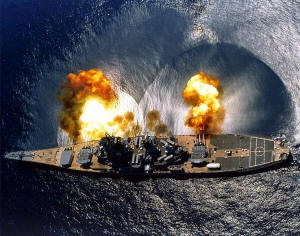|
Nuclear Post Visits to Denmark During the Cold War
 The issue of nuclear weapons onboard U.S. warships visiting
Danish ports pestered U.S.-Danish relations for more than 40 years. Ever since
the first nuclear-capable warships began arriving in the late 1950s, the issue
of whether the ships carried nuclear weapons became a recurrent issue for the news
media, peace
activists, political parties, and sometimes even national elections. The issue of nuclear weapons onboard U.S. warships visiting
Danish ports pestered U.S.-Danish relations for more than 40 years. Ever since
the first nuclear-capable warships began arriving in the late 1950s, the issue
of whether the ships carried nuclear weapons became a recurrent issue for the news
media, peace
activists, political parties, and sometimes even national elections.
Denmark's policy against nuclear weapons on its territory was
first stated in 1957, and in the following years the policy was gradually
clarified to explicitly include even brief visits to Danish ports by warships.
Danish governments always insisted that the ban was well-known to the nuclear
powers and that they therefore also respected it, but because of numerous
indications over the years that visiting warships brought nuclear weapons in
anyway the governments' position became increasingly tenuous.
After the crash of a U.S. nuclear-armed B-52 bomber in
Greenland in January 1968, the Danish government received assurances from the
United States that nuclear weapons would not be stored on land in Greenland or
flown over the island without the Danish government's consent (see
Greenland section for description of these events). The agreement only
concerned Greenland, however, and excluded port visits. This gave the United
States a diplomatic go-ahead to continue nuclear port visits to Denmark.
Paul Warnke, the former U.S. assistant secretary of defense
and SALT II negotiator, bluntly acknowledged in an interview in April 1988 with
Danish reporter Jorgen Dragsdahl:
Warnke: Your government knows very well that we have
brought the [nuclear] weapons in.
Dragsdahl: How do you know there are nuclear weapons onboard when the
warships visit Denmark?
Warnke: The armament of a warship is not changed just because of a
port visit. What should they do. Put them on a barge in the meantime? Or first
leave them in the United States and then pick them up again? Of cause they don't
want to do that.
Dragsdahl: So the U.S. has violated the Danish policy which has been
effect for 30 years?
Warnke: That is correct and you have accepted it.
Rear Admiral Eugene Carroll, who was chief of
U.S. military operations in Europe and the Middle East under President Carter, added
during a visit to Denmark in May 1988:
Carroll: We do not move nuclear weapons at sea
simply because we're going to a harbor that can't accept nuclear weapons.
That procedure is much too complicated.
In spite of such statements, and increasingly compromising
research by independent researchers, Danish governments insisted that
the nuclear powers respected Denmark's ban against nuclear weapons. This turning a
blind eye to the violations became a diplomatic recipe for disaster and
essentially guaranteed that each port visit became a major political event. Not until the United States in June 1992 announced that it had
removed all tactical nuclear weapons from its warships was this unnecessary
irritant removed from U.S.-Danish relations. For more information, check the
following items:
»
The 1988 national election.
»
Chronology of nuclear-capable warship visits to Denmark.
»
Profiles of individual port visits by nuclear-capable warships.

©
Hans M. Kristensen |
www.nukestrat.com | 2004-2005
|

